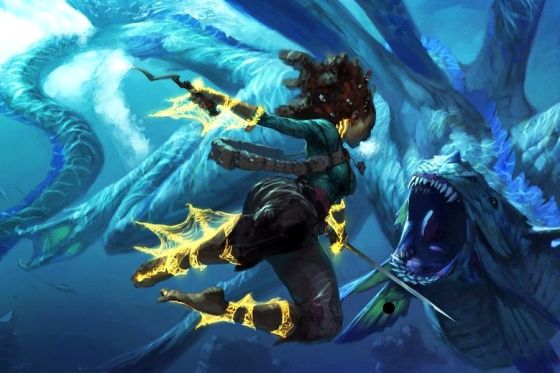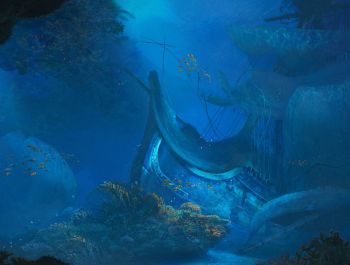Difference between revisions of "Underwater Adventures"
Tao alexis (talk | contribs) |
Tao alexis (talk | contribs) |
||
| Line 40: | Line 40: | ||
== Movement == | == Movement == | ||
| + | As ever, the character's movement is dictated by the number of action points he or she has. | ||
Revision as of 19:02, 7 October 2022
Underwater Adventures embodies those parts of the game campaign taking place in the watery environment of oceans, seas and lakes, which are strange and provocative places for the player characters to explore. The mysterious lands under the sea are also home to numerous, ancient submarinal races and civilisations, consisting of green realms of fish-like humanoids, also perpetually threatened by monsters. Tales of sunken loot are sure to persuade the players that opportunities for plunder put surface lairs and dungeons to shame, with such stories of pearls as large as grapefruits and ships with gargantuan piles of coin poured onto the ocean floor, waiting to be found by intrepid soldiers of fortune.
Yet the difficulties of exploring the ocean are as frightful as the monsters that dwell in the depths. Surface humanoids aren't designed to breathe water, nor to swim as easily as those creatures bred for the water. Great treasures there may be, but overcoming the character's inadequacies in the environment are a large part of why enormous wealth continues to languish, untouched, in such amounts. A set of special rules must be implemented for the players to observe when attempting underwater escapades; this page attempts to aid the DM in handling such adventures practically, in a manner that continues to provide the players with excitement and problems to solve.
Breathing Underwater
A primary concern for the party is the ability to breathe underwater. This can be managed in various ways. Effective spells include water breathing and airy water, with magical items such as a potion of water breathing, the helm of underwater action or the robe of the manta ray. Another tactic would be to employ shape change or polymorph, in order to take a form that's able to breathe and move easily underwater. Specific herbs and sage abilities may also provide limited means of breathing underwater. There's always a danger with medicinal forms of altering the body, however, in that individuals may find they're able to live continuously underwater with a time limit, while finding themselves now unable to breathe air as they once did.
Visibility
Without special adjustments to the character's ability to see, such as the use of goggles, characters should discover that water is much more opaque than air. Distinct underwater vision is limited to a mere 20 feet, or four combat hexes; between 21 and 30 feet, all attacks suffer a -2 penalty to hit; this is increased to -5 between 31 and 40 feet. Beyond 40 feet, objects larger than 10 feet in diameter are vaguely discernable to a distance of 60 feet. Beyond this distance, nothing is discernable except the vague background of hazy water. These limitations can be improved 100% by the ultravision spell.
Naturally, this puts a party adventuring underwater at a considerable disadvantage, particularly since many underwater monsters move at a tremendous speed, enabling them to manifest out of the watery semi-darkness in mere seconds, so that if they should win initiative they're quite able to snap at a character, causing damage, before disappearing once again into the gloom.
| Depth | Illumination | Reduction to Visibility |
|---|---|---|
| 101-150 ft. | Dusk | -20% |
| 151-230 ft. | Full moonlight | -30% |
| 231-360 ft. | Dim moonlight | -50% |
| 361-570 ft. | Starlight | -70% |
| below 570 ft. | Full dark | -100% |
Worse, all vision effects can be drastically reduced by a fall in illumination, either due to the character's depth below the surface or the reduction of illumination caused by night. The table shown gives adjustments to visibility due to either of these factors — which are, when applied together, cumulative. For example, if the character descended to 120 feet below the surface, and the setting of the sun reached dusk, then the character's visibility would be reduced by 40% of normal.
Illumination can push back this decline, but obviously forms of illumination depending upon a flame or some form of fuel are useless underwater. Water cumulatively absorbs 20% of light for each 10 ft. of distance from the source; this means that a light spell would be only 40% effective at a distance of 30 ft., and not effective at all beyond 50 ft. Comparing this to the table shown, a visibility reduction of -50% would be nullified completely up to 20 ft., adjusted to -10% from 21 to 30 ft., then to -30% from 31 to 40 ft. and completely ineffective beyond that point.
However, a character can observe an illuminated object in darkness underwater to a distance of 120 ft., even if absolutely nothing else can be seen in the murk. This provides a reference point for characters to locate, to reduce the danger of getting lost. Such points should be a refuge for the players to retreat to, perhaps among rocks or in a small cave, which is defensible. A character doesn't want to be caught in utter darkness! Many dangerous predators can see perfectly well in reduced illumination, against which the character would be quite helpless.
Sound
While it's true that the suppression of voice and hearing between the party members might add a greater sense of the underwater experience, with players around the table using hand signals and directions rather than speaking their minds, in terms of game play I believe this would quickly become frustrating and impractical. Therefore, a component of water breathing magic enables characters to speak to one another normally.
Unlike visibility, water amplifies sound, arguing that the transformation of voices and understanding allows characters to speak normally to a distance twice that on the surface, or 120 feet. Shouting distance is enhanced to 240 ft. Further, directional comprehension of sound is also affected by magic, enabling characters to identify where a sound is coming from as well. The characters may not be able to see an enemy, but there's a high likelihood that hearing an enemy may offer them warning. Overall, with visibility reduced and audial references increased, the chance of surprise remains the same.
Movement
As ever, the character's movement is dictated by the number of action points he or she has.

